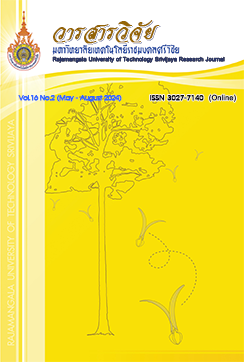Development of Nitrogen Oxides (NOx) Emission Prediction Model of Nam Phong Power Plant with Machine Learning
Keywords:
NOx prediction, Machine Learning, Nam Phong power plant, CEMS, PEMSAbstract
Nitrogen Oxides (NOx) are harmful gases to human health and the environment. These emissions primarily result from fuel combustion in engines and industrial processes. To meet regulatory requirements, the Nam Phong Power Plant in Thailand has implemented Continuous Emission Monitoring Systems (CEMS) to measure and report NOx emissions to regulatory authorities. However, considering the high costs associated with installing and maintaining CEMS, as well as recent changes in Thai legislation allowing for predictive NOx measurement methods, it is worth exploring the use of Machine Learning as a reliable method for estimating NOx emissions accurately. In this study, a comprehensive comparison was conducted on six Machine Learning algorithms: Linear Regression, Decision Tree, Random Forest, XGBoost, K-Nearest Neighbors, and Backpropagation Multilayer Perceptron Neural Network. Among these models, Random Forest emerged as the top performer, exhibiting superior performance metrics, including the lowest MAE, MAPE, and the highest R² scores. These results underscore the potential accuracy and reliability of Random Forest in predicting NOx emissions. Furthermore, research on feature importance has revealed the significant influence of certain parameters on model accuracy. These parameters include steam injection flow, steam injection temperature, and ambient conditions. The influence of controllable factors, such as the temperature of steam injection, on NOx emissions is noteworthy. These findings not only hold promise for enhancing the precision of predictive models but also present opportunities to decrease NOx emission levels while maintaining plant efficiency.
References
Brown, S. 2021. Machine learning, explained - MIT Sloan. Artificial Intelligence. Available Source: https://mitsloan.mit.edu/ideas-made-to-matter/machine-learning-explained, September 3, 2023.
Chawathe, S.S. 2021. Explainable predictions of industrial emissions, pp. 1-7. In 2021 IEEE International IOT, Electronics and Mechatronics Conference (IEMTRONICS). IEEE, New Jersey.
Chien, T.W., Chu, H., Hsu, W.C., Tseng, T.K., Hsu, C.H. and Chen, K.Y. 2003. A feasibility study on the predictive emission monitoring system applied to the Hsinta power plant of Taiwan power company. Journal of the Air & Waste Management Association 53(8): 1022-1028.
Department of Industrial Works. 2007. Notification of Department of Industrial Works 2007 Title: Data Transmission into the system of Continuous Emission Monitoring System. Government Gazette vol.124, Special Part 196. (dated October 10, 2007). (in Thai)
Great Learning Team. 2023. Hyperparameter Tuning with GridSearchCV. AI and Machine Learning. Available Source: https:// www.mygreatlearning.com/ blog/gridsearchcv, September 5, 2023.
Huang, D., Tang, S., Zhou, D. and Hao, J. 2022. NOx emission estimation in gas turbines via interpretable neural network observer with adjustable intermediate layer considering ambient and boundary conditions. Measurement 189: 110429.
Kaya, H., Tüfekci̇, P. and Uzun, E. 2019. Predicting CO and NOx emissions from gas turbines: novel data and a benchmark PEMS. Turkish Journal of Electrical Engineering and Computer Sciences 27(6): 4783-4796.
Kochueva, O. and Nikolskii, K. 2021. Data analysis and symbolic regression models for predicting CO and NOx emissions from gas turbines. Computation 9(12): 139.
Ministry of Industry. 2022. Notification of Department of Industrial Works 2022 Title: Mandating factories to install special tools or equipment for reporting air pollutants emitted from factory stacks. Government Gazette vol.139, Special Part 131. (dated April 1, 2022). (in Thai)
Potts, R., Hackney, R. and Leontidis, G. 2023. Tabular machine learning methods for predicting gas turbine emissions. Machine Learning & Knowledge Extraction 5(3): 1055-1075.
Rezazadeh, A. 2020. Environmental pollution prediction of NOx by predictive modelling and process analysis in natural gas turbine power plants. ArXiv 1: 8978.
Rosner, B., Glynn, R.J. and Lee, M.L.T. 2006. The Wilcoxon signed rank test for paired comparisons of clustered data. Biometrics 62:185-192.
United States Environmental Protection Agency. 2023. Basic information about NO2. Nitrogen Dioxide (NO2) Pollution. Available Source: https://www.epa.gov /no2-pollution/basic-information-about-no2, September 4, 2023.
Witten, I.H. and Frank, E. 2005. Data Mining: Practical Machine Learning Tools and Techniques. 2nd ed. Elsevier, Amsterdam.
Downloads
Published
How to Cite
Issue
Section
License
Copyright (c) 2024 Rajamangala University of Technology Srivijaya Research Journal

This work is licensed under a Creative Commons Attribution-NonCommercial-NoDerivatives 4.0 International License.
The content and information in the article published in Journal of Rajamangala University of Technology Srivijaya It is the opinion and responsibility of the author of the article. The editorial journals do not need to agree. Or share any responsibility.







